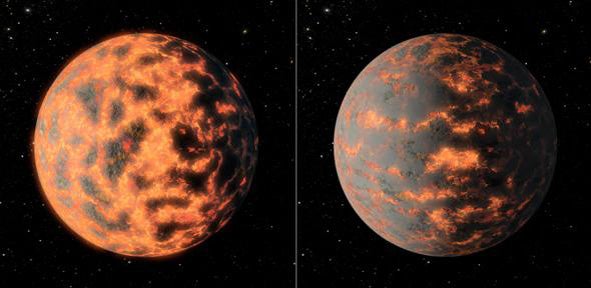Using NASA’s Spitzer Space Telescope, the researchers observed thermal emissions coming from the planet, called 55 Cancri e — orbiting a Sun-like star located 40 light-years away in the constellation Cancer — and for the first time found rapidly changing conditions, with temperatures on the hot “day” side of the planet swinging between 1,800° and 4,900° F (1,000° and 2,700° C).
“This is the first time we’ve seen such drastic changes in light emitted from an exoplanet, which is particularly remarkable for a super-Earth,” said Nikku Madhusudhan of Cambridge’s Institute of Astronomy. “No signature of thermal emissions or surface activity has ever been detected for any other super-Earth to date.”
Although the interpretations of the new data are still preliminary, the researchers believe the variability in temperature could be due to huge plumes of gas and dust, which occasionally blanket the surface that may be partially molten. The plumes could be caused by exceptionally high rates of volcanic activity, higher than what has been observed on Io, one of Jupiter’s moons and the most geologically active body in the solar system.
“We saw a 300 percent change in the signal coming from this planet, which is the first time we’ve seen such a huge level of variability in an exoplanet,” said Brice-Olivier Demory of the University’s Cavendish Laboratory. “While we can’t be entirely sure, we think a likely explanation for this variability is large-scale surface activity, possibly volcanism, on the surface is spewing out massive volumes of gas and dust, which sometimes blanket the thermal emission from the planet so it is not seen from Earth.”
55 Cancri e is a “super-Earth,” a rocky exoplanet about twice the size and eight times the mass of Earth. It is one of five planets orbiting a Sun-like star in the constellation Cancer and resides so close to its parent star that a year lasts just 18 hours. The planet is also tidally locked, meaning there is a permanent “day” side and a “night” side. Since it is the nearest super-Earth whose atmosphere can be studied, 55 Cancri e is among the best candidates for detailed observations of surface and atmospheric conditions on rocky exoplanets.
Most of the early research on exoplanets has been on gas giants similar to Jupiter and Saturn since their enormous size makes them easier to find. In recent years, astronomers have been able to map the conditions on many of these gas giants, but it is much more difficult to do so for super-Earths: exoplanets with masses between one and 10 times the mass of Earth.
Earlier observations of 55 Cancri e pointed to an abundance of carbon, suggesting that the planet was composed of diamond. However, these new results have muddied those earlier observations considerably and opened up new questions.
“When we first identified this planet, the measurements supported a carbon-rich model,” said Madhusudhan, who along with Demory is a member of the Cambridge Exoplanet Research Center. “But now we’re finding that those measurements are changing in time. The planet could still be carbon rich, but now we’re not so sure — earlier studies of this planet have even suggested that it could be a water world. The present variability is something we’ve never seen anywhere else, so there’s no robust conventional explanation. But that’s the fun in science — clues can come from unexpected quarters. The present observations open a new chapter in our ability to study the conditions on rocky exoplanets using current and upcoming large telescopes.”










